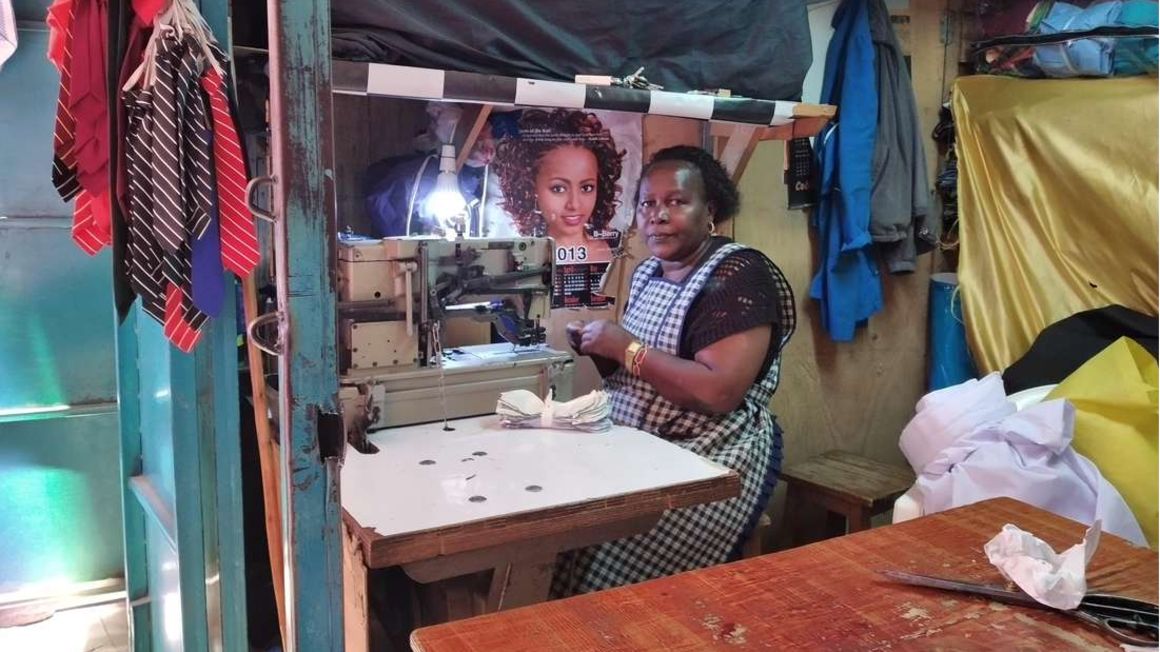
Ms Wangeshi Waithaka prepares her stitching machine for sewing school uniforms as well as masks at his stall in Uhuru Market, off Jogoo Road, Nairobi County. PHOTO | POOL
Summary
- For more than four decades, John Saisi has perfected the art of making footballs in his cramped stall at Uhuru Market in Nairobi County.
- With his skillful hands, Mr Saisi is certain he has moulded generations of footballers while earning a decent income.
- Through the business, he has educated his ten children who have studied up to university.
For more than four decades, John Saisi has perfected the art of making footballs in his cramped stall at Uhuru Market in Nairobi County.
With his skillful hands, Mr Saisi is certain he has moulded generations of footballers while earning a decent income.
Through the business, he has educated his ten children who have studied up to university.
“When I first came into this market in 1978, I began with a general shop before shifting into football-making that year,” Mr Saisi says, adding that he ventured into the occupation to tap onto the popularity of the sport, which was growing exponentially.
His clientele base includes schools, individuals, supermarkets, among others.
The market, which is Nairobi’s oldest textile hub, was first launched in 1976. Then, it comprised of four concrete mixed-use and nine semi-permanent market structures that housed over 1, 000 traders in textile and apparel value chain.
For decades, the market has nurtured numerous business dreams and provided jobs and livelihoods for thousands of people.
“Ball prices range from Sh1,000 to Sh300, depending on the size. Adult balls cost Sh1,000, teens’ Sh400 whereas those for small kids cost Sh300,” says Mr Saisi who is in his 70s.
On average, he sells 400 to 500 balls per month, earning him more thanSh100,000.
He sources his raw materials from Juakali and retail vendors. Some of the materials he uses include cowhide, special stitches, glues, rubber bladders and stitchings.
Mr Saisi is one of the almost 6,000 traders occupying 324 stalls at the Uhuru market. Currently, 62 percent of trader are female while 38 percent are male. Overall, 64 percent of dealers engage in textile production with uniform production taking the lion share of 36.1 percent.
The traders, however, has a number of challenges. The market lacks basic services and Mr Saisi urges the county government of Nairobi to modernise the facility and revamp utilities such as sewerage system, floodlights, parking area and build a perimeter wall.
“As a former secretary of the market for more than 20 years, I wrote so many letters to the defunct city council to conduct the above-mentioned renovations. However, only a few of my requests have been addressed so far,” he says.
“Lately, they have fixed new corrugated sheets. Before when it rained water would seep into our stalls and destroy merchandise thus causing heavy losses. But, there are many works that they have not done such as sewage, water, electricity supply.”
Another trader, Stephen Mbugua has been operating a business at the market for the last 25 years.
Mr Mbugua sells ladies’ clothes as well as purses.
“Before, I used to sell furniture and vegetables,” he says.
One of the challenges Mr Mbugua faces is competition from big businesses in Eastleigh that sells at low prices. High costs are also a hindrance.
“For example, a huge electricity bill eats into my profit margin thus making competition even harder,” he says.
Another trader, Wangeshi Waithaka who has been dealing in traditional clothes since 1996 owes her success to the market.
“I sell my merchandise at the Maasai market for tourists but since their arrival was affected by the pandemic sales have dropped dramatically,” he says.
With the earning from the business, Ms Waithaka has educated her two children, one of whom studied at the Multimedia University, with another in Form One. He says prices for her goods range between Sh700 and Sh3 000. For wholesale, she sells at Sh500.
The adverse effects of the pandemic has significantly eaten into his margin.
“I used to make Sh30,000 per month but now I only make Sh5,000 due to Covid-19 disruption,” he says.
The traders are required to pay the county from Sh2,000 to Sh4,000 per month, further adding the cost burden.




No comments :
Post a Comment